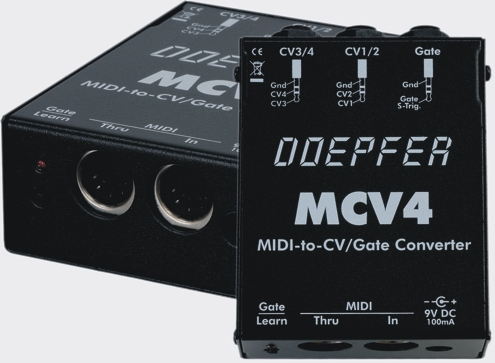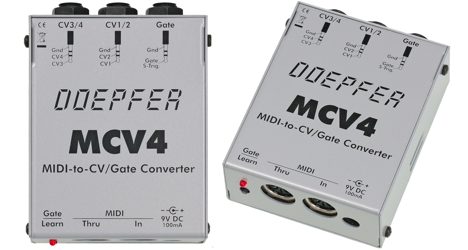|
MCV4 |
|
|
MIDI-to-CV/Gate Interface |
|

|
|
|
schwarze Version
(produziert ab Frühjahr 2011) / black version (manufactured
from spring 2011) Klicken Sie auf das Bild um ein Foto mit höherer Auflösung zu erhalten / Click to the picture to obtain a higher resolution picture |
|
|
|
|

|
|
|
silbergraue
Version (produziert bis Frühjahr 2011) / silver-grey
version (manufactured until spring 2011) Klicken Sie auf das Bild um ein Foto mit höherer Auflösung zu erhalten / Click to the picture to obtain a higher resolution picture |
|
|
|
|
|
MCV4 ist ein preiswertes MIDI-to-CV-Interface, mit dem monophone Synthesizer über MIDI angesteuert werden können. MCV4 liefert 4 analoge Steuerspannungen (CV1...4) und ein Gate- bzw. Trigger-Signal. |
MCV4 is a budget-priced MIDI-to-CV-Interface to control vintage monophonic synthesizers via MIDI. MCV4 is provided with 4 analog control voltage outputs (CV1...4) and one Gate/Trigger output. |
| Hier die wichtigsten Eigenschaften des MCV4: | These are the most important MCV4 features: |
| 4 analoge Ausgangsspannungen CV1...CV4 | 4 analog control voltages CV1...CV4 |
| Spannungsbereich für CV1...4 jeweils 0...+5V, Auflösung 8 Bit (entspricht 1/4 Halbton) | voltage range for CV1...4: 0...+5V, 8 Bit resolution (equivalent to 1/4 semitone resolution) |
| CV1 für Tonhöhen-Steuerung (VCO) | CV1 for pitch control (normally VCO CV) |
| CV2...4 zur Steuerung anderer Funktionen (z.B. VCF, VCA) | CV2...4 for voltage control of other functions (e.g. VCF frequency, loudness, modulation) |
MIDI-Ansteuerung von
CV1..4:
|
MIDI control of
CV1..4:
|
| Pitch-Bend-Berücksichtigung für CV1 (1/4 Halbton Auflösung) | pitch-bend is used for CV1 generation with 1/4 semitone resolution |
| Gate-Ausgang per Jumper (Steckbrücke) im Gerät zwischen Spannungstrigger (+5V oder Netzteilspannung) und S-Trigger umstellbar | gate output type can be selected via jumper inside the device between voltage trigger (+5V or power supply voltage) and S-trigger (switched trigger) |
| MIDI-Kanal und Referenzton (für CV1) über Lern-Taster einstellbar | MIDI channel and reference note for CV1=0V adjustable via learn button |
| verschiedene Zuordnungsalgorithmen für CV1 einstellbar (highest note, last note, reference note) | different assign modes for CV1 (highest note, last note, reference note) |
| Retrigger an/aus bei Legato-Spiel | retrigger on/off while playing legato |
| Gate/Trigger-Polarität normal/invertiert | gate/trigger polarity normal/inverted |
| zwei 6.35 mm-Stereo-Klinkenbuchsen für CV1/2 und CV3/4 | two 1/4" stereo jack sockets for CV1/2 and CV3/4 |
| 6.35 mm Mono-Klinkenbuchse für Gate/Trigger | 1/4" mono jack socket for gate/trigger |
| Lern-Taste mit Leuchtdiode für die Einstellung von MIDI-Kanal, Referenzton für CV1 und Controller-Nummer für CV4 | learn button with LED for adjusting MIDI channel, reference note for CV1, controller for CV4 |
| optische Anzeige von Gate über die Leuchtdiode | optical display of gate/trigger via LED |
| MIDI-In, MIDI-Thru | MIDI-In, MIDI-Thru |
| nicht flüchtige Speicherung aller Einstellungen im Gerät | non-volatile memory for parameter settings |
|
stabiles Metall-Gehäuse
(ca.
95x75x35
mm, 1mm Stahlblech) Bis Frühjahr 2011 war die Gehäusefarbe silbergrau. Ab Frühjahr 2011 ist die Gehäusefarbe auf schwarz. |
stable metal case (about
95x75x35
mm, 1mm sheet steel) Until spring 2011 the case color was silver-grey. From spring 2011 the case color is black. |
| Stromversorgung über externes
Steckernetzteil 230V mit Eurostecker bei Lieferungen innerhalb Europas ist ein Steckernetzteil für 230V mit Eurostecker enthalten Netzteile für andere Netzstecker oder Netzspannungen müssen vom Benutzer im jeweiligen Land erworben werden, 7...12V/100mA DC erforderlich, Kleinspannungsstecker mit 5,5 mm Außen-Durchmesser und 2,1 oder 2,5 mm Innen-Durchmesser, Polung: plus innen/minus außen |
external AC adapter for power supply AC adapter for 230V AC and European type of mains connector is included within Europe adapters for other voltages or other mains connector types has to be purchased by the customer in his country, 7...12V/100mA DC required, DC connector with 5.5 mm outer diameter and 2.1 or 2.5 mm inner diameter, polarity: plus = center, minus = ring, please ask the representative in your country if you cannot find a suitable supply |
| Die deutsche MCV4-Bedienungsanleitung ist als pdf-Datei auf unserer Web Site verfügbar: MCV4_Anl.pdf | The english MCV4 user's guide is available as pdf file on our web site: MCV4_man.pdf |
|
Preise: Euro 120.00 incl. Steckernetzteil für 230V mit Eurostecker Euro 115.00 ohne Netzteil |
Prices: Euro 120.00 incl. 230V power supply with European plug type Euro 115.00 without power supply The prices in US$ depend upon the exchange rate between Euro and US$ at the payment day. Free currency converter: |
|
Passendes Zubehör: MCV4 Spezial-Kabel (6.35 Stereo-Klinkenbuchse auf 2 x 6.35mm Mono-Klinkenbuchse, ca. 90cm lang, auch "Insert-Kabel" genannt): Euro 7.00 pro Stück Wir empfehlen Ihnen das Kabel bei Bedarf gleich mitzubestellen, da eine spätere Nachlieferung wegen des geringen Warenwertes nicht möglich ist, bzw. mit höheren Kosten verbunden ist (Mindermengenzuschlag) |
Suitable accessories: MCV4 special cable (1/4" stereo jack plug -> 2 x 1/4" mono jack plug, length about 90cm, also called "insert cable"): Euro 7.00 each. If desired please order the cable together with the MCV4 as a separate order only for the cable cannot be accepted resp. causes high processing charges because of the small value for the cable only. |
|
Ergänzende Erläuterungen: Der MIDI-Kanal, der Referenz-Ton für CV1 (dies ist die MIDI-Tonhöhe, der 0V
CV1 und damit der tiefstmöglich Ton entspricht) und die Controller-Nummer für
CV4 werden über eine Lern-Funktion eingestellt. Hierzu wird der Lern-Taster
betätigt und über MIDI der betreffende Befehl gesendet. Die anderen Parameter
(Retrigger, Triggerpolarität etc.) werden im Lern-Modus über
Program-Change-Befehle eingestellt. Weitere Hinweise finden Sie in der MCV4-Bedienungsanleitung MCV4_Anl.pdf und auf unserer FAQ-Seite. |
Additional Remarks: MIDI channel, reference note for CV1 (this is the MIDI note corresponding to 0V
of CV1 and thus the lowest possible note of the analog synthesizer connected to
MCV4) and the controller no. for CV4 are adjusted via learn function. For this
the learn button must be pressed and the required MIDI messages sent from the
MIDI controlling device (MIDI synthesizer, keyboard, sequencer ...). The other
parameters (retrigger, trigger polarity, assign mode ...) are adjusted in learn
mode via program-change messages. More details can be found in the user's guide MCV4_man.pdf and on the FAQ page. |